In the context of moving Earth, there are a lot of movement types that are present in the crust. For studying those movements and their results, geology had served from geometry, creating the “structural geology” which is the discipline that unravels the deformations, forces, and structures that can be appreciated at sight or by indirect methods.
The main forces or stresses (force per unit area) in the crust are: compressive, tensional, and shear. They make shortening, extensional and shear strains respectively. The strain itself is described as the change in size or shape during a stress process.
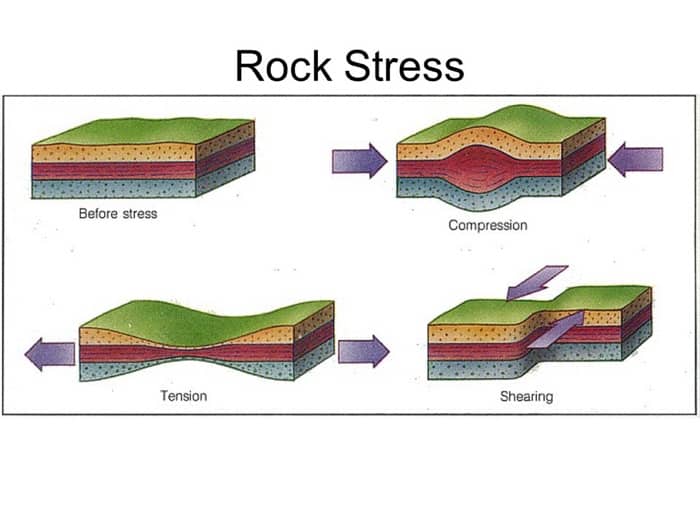
The deformation of the rocks could be elastic, plastic or ductile, and fragile or brittle. It’s worth it to remember those concepts since are fundamentals.
An elastic deformation it’s the one that recovers its original shape after stress but has a limit that once broken, the rocks present a permanent strain. In a plastic (or ductile) deformation, constant stress is present in the rocks for millions of years, making a progressive and permanent strain by the flow. Finally, brittle deformations occur when a relevant accumulation of stress is liberated quickly. Rocks won’t present a relevant strain while enduring this accumulation, but when it reaches a limit when the rocks can’t hold it anymore, a fracture occurs, liberating the stored stress and generating permanent and violent deformations.
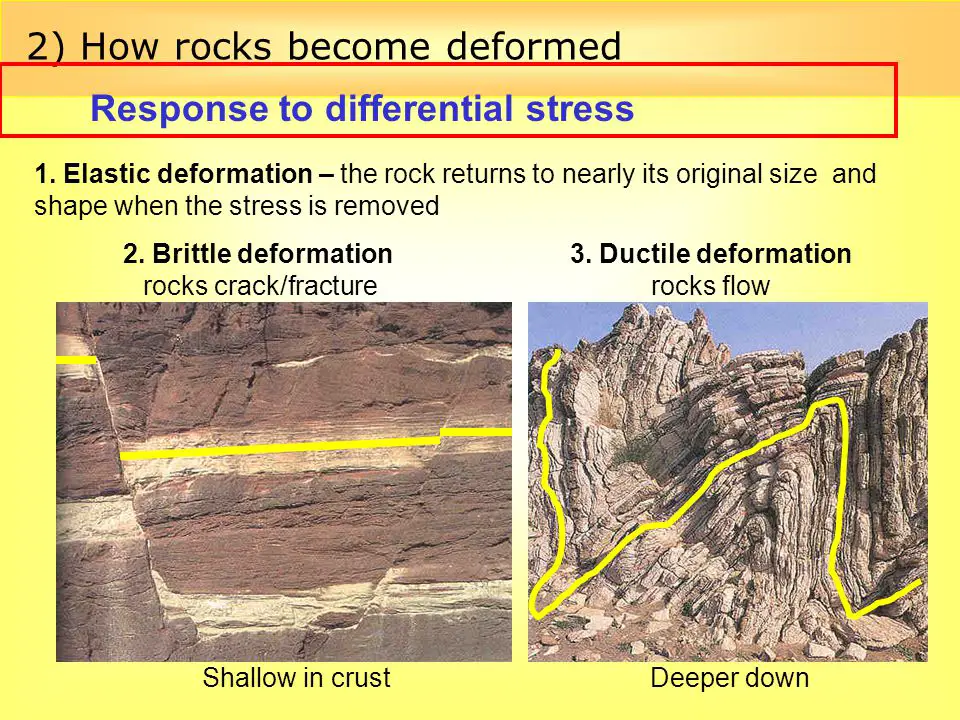
Pressure, temperature, time, and the type of rock are the main elements that determine what kind of deformation will take place in any given volume of the crust.
What is a geological fault?
Geological faults are fractured surfaces along which appreciable displacement has taken place; are usually created by brittle deformation of the crust.
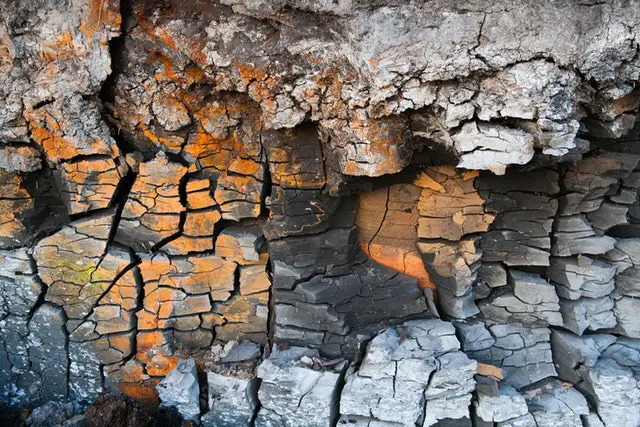
There are “small” faults that can be appreciated in a roadway that could have a few kilometers and there are larger faults that could take tens or hundreds of kilometers of extension. The San Andreas Fault is a famous one with almost 1300 km long and almost 16 km in depth.
Faults are linked to folding and plate tectonics movements, sometimes being (and only part) of their formation or structure itself.
To study the different types of faults it’s necessary to make an abstraction supported by geometry, usually approaching a fault as a simple structure, but in reality, they are more often being part of a complex system of faults and structures.
That being said, another frequent phenomenon is that a fault can have ramifications of the same type, so even simple faults could have many branch lines, making it a complicated system of a single type of fault.
A fault has the next components:
- Fault plane: It’s the geometric surface used to delimit the plane in which the relative movement has taken place. Could be vertical or with an angle
- Cut-off lines: It’s the relative moment of the bodies of rock moved, the trace of the displacement. Occur in pairs, one on each side of the blocks moved.
- Slip: It’s the relative displacement of formerly adjacent points, represented by the relative slip vector. It’s a total displacement, resulting from the accumulation of small slips, not necessarily parallel to the slip vector. “Dip slip” and “strike-slip” are components of the net slip.
- Separation: It’s the distance between two displaced planes, usually measured on the fault perpendicular to the cut-off lines, but more commonly in the strike or dip directions.
- Foot block and footwall: The foot block it’s the mass of rock that keeps stable after the displacement. The surface bounding it’s the footwall.
- Hanging block and Hanging wall: The hanging block it’s the mass of rock that moves relative to the foot block after the displacement. The surface bounding it’s the hanging wall.
To determine which block of rock had moved relative to the other it used the rock strata as a first option. Examining the nearby structures and the main stresses acting in the zone it’s also helpful.
Main types of faults and the forces that generate them
As said in the introduction, there are three main types of stresses that cause strains in the crust. The type of stress presented in a certain volume of rocks depends on many things, but usually, it’s linked to the movement of the plate tectonics.
Compressive stresses are related to convergent boundaries, orogeny, and some catastrophic events. Tensional or extensional stresses are related usually to divergent boundaries, hotspots, and rift valleys. The case of shear stresses is more complicated since could be found in many different scenarios, not only next to transform boundaries. This last stress it’s commonly found combined in some zones with the other two types of stress.
Dip-slip faults
The easiest type of fault to identify is the dip-slip fault. The movement is primarily parallel to the dip (or inclination) and it’s practical to use the foot block & hanging block concepts to identify the type of fault to study.
The fault plane it’s not vertical, but in some cases, it could be similar to it. The normal and reverse faults are the main types of dip-slip faults.
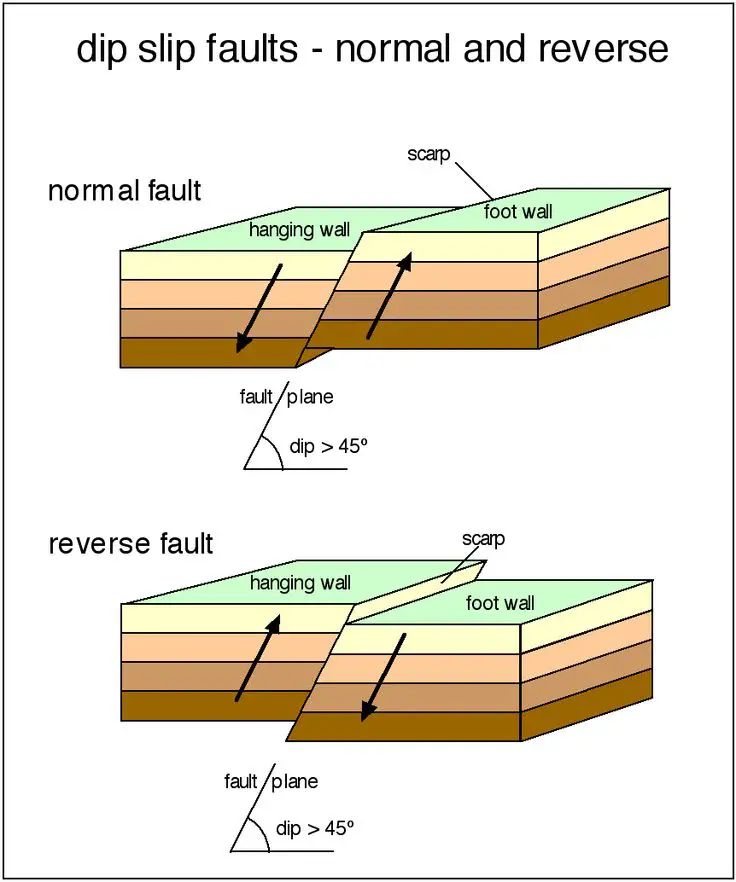
Normal faults
A normal fault occurs when the hanging block it’s below the foot block and is usually found in areas dominated by tensional stress. The angle of the fault plane use to be equal to or similar to 60° and are the most common type of fault on the planet.
They are present in many mountain ranges, rift valleys, and spreading margins of the tectonic plates. The case of rift valleys is particularly related to a series of normal faults since the valleys are formed by the sliding of the hanging walls, in a similar way to a stairway, but in this case, the hanging blocks became the valley floors.
Reverse faults
It’s the opposite case of normal faults. In this case, the hanging black ends above the foot block are related to compressional stresses. These types of faults are rarer than the normal faults since more stress has to be stored to make a reverse fault in comparison to the normal one. Also, when a reverse fault is present, that means that the crust has been shortened.
Reverse faults have equal or more than 45° in their dip; when the angle it’s less than that it became and thrust fault.
Thrust faults
They are a special case of a reverse fault, in which the hanging wall it’s not only up to the footwall, but the hanging block could be directly above the foot block. Thrust faults could be almost horizontally and are larger than the reverse faults, having from tens to hundreds of kilometers long. The Appalachian thrust faults have more than 50 kilometers of displacement.
A relatively commonplace to find one it’s on the top section of mountains and convergent plate boundaries. Since the compressional stress environment has to be really dominant to generate a thrust fault, it’s common to find folds associated with these faults.
Strike-slip fault
In these faults the fault plane it’s almost vertical (90°) so there’s no visible inclination or dip. Strike-slip faults are also not well determined by the hanging and foot walls, since little vertical displacement can be noticed. Instead, they’re classified by the direction of the relative movement of the opposite block looked at by an observer.
When the opposite block has moved to the right, it’s called a right-lateral or dextral fault. If the relative movement it’s to the left, it’s called left-lateral or sinistral fault.
This classification could be confusing at the beginning, thinking that if you change the position of the observer the relative movement could be different, but this is not the case. For example, if an observer it’s put in front of a dextral fault, will appreciate the relative movement of the opposite (or far) block to the right, comparing the structures in the ground, mountains, etc. Taking this image, you can say that there are mountains in front of the observer, and let’s say, a lake behind of him. If you move the observer to the other side, having the mountains behind and the lake in front, the observer will still see a relative displacement of strata and ground structures to the right in the opposite block.
Strike-slip faults are also really common and are not attached to an explicit stress environment, but are more often found in the ocean crust than in the continental crust. They could be extremely large, just like the San Andreas fault. Regular strike-slip faults are also called transcurrent faults.

Transform faults
It’s a special case of strike-slip faults and is found in a combination of divergent boundaries, being part of the boundary itself. Transcurrent faults are not part of plate boundaries.
Transform faults form a zig-zag patron with the divergent boundaries, being the end of these boundaries and acting as a junction to another divergent plate boundary. In contrast, transcurrent faults could end without any junction to another structure, fault, or boundary.
Main structures made by faulting and complex faults systems
It has to be noted that combinations of the simple type of faults are common in reality. There could be reverse dextral faults or normal left-lateral faults, for make some examples. However, the combination of these structures can be really varied because the stress environments can change drastically over millions of years, so an area that once was dominated by tensional stress, then could have been so by compressional stress, making intricated combinations.
There’re also other common but complex systems to note:
Graben and Horst
When a large volume of the crust is dominated by normal faults, like in the case of rift valleys, the down-dropped blocks are called grabens, and the uplifted blocks are called horsts.
These structures could be found paired, but also could be found alone in some way. For example, a rift valley could be formed only by a sequence of grabens that ends with a final floor, not necessarily too uplifted. On the other hand, a fault-block mountain range could be a sequence of horsts. By definition, there will always be a graben next to a horst, but when there’s a sequence of one of them and only one of its complement, it’s more like a natural ending of that sequence.
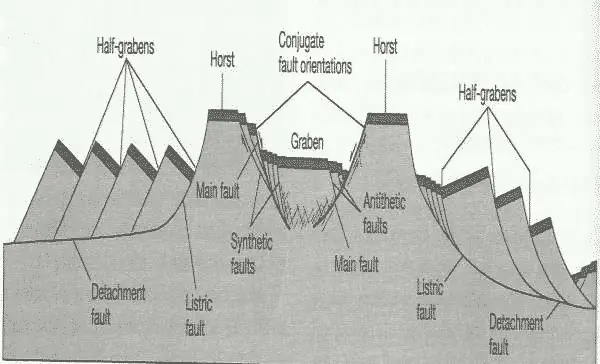
Duplex systems
A duplex, or duplex structure, is an imbricate family of thrust faults that branch off from an original or “floor” thrust and a curve upward that joins a “roof” thrust. The thrust in the middle is called “horses” and have a variety of different forms and sizes, depending on the displacement of the individual horses. The lowest thrust of the group is commonly referred to as the sole thrust
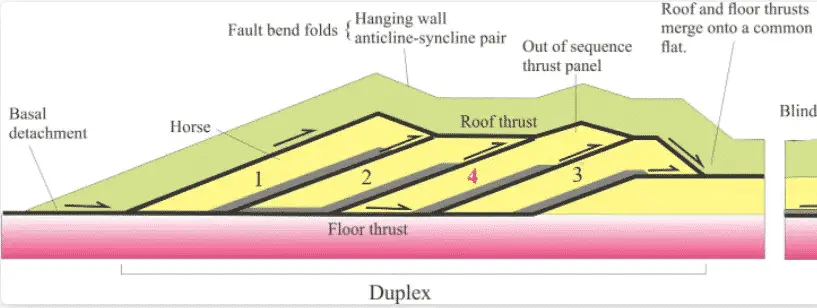
Fault-bend and fault-propagation folds
These cases are associated with fold and thrust belts, usually near or into orogenic belts. They are combinations of folding and faulting, so here the plastic deformation it’s also taken in the study, but in general, are cases in which faults are presented into fold cores.
In these fold cores, when attempting to restore the pre-fold geometry, there seems to be a deficiency of mass in the core of the folds, just as in the case of the folds with rounded forms, and in order to resolve that problem, the fault-bend and fault-propagation fold models where proposed.
A fault-bend fold is called when, as a result of movement on a generally curved fault, at least one of the blocks must deform in order to maintain contact across the fault.
Fault-propagating folds are proposed when thrust faults are propagating, lose their slip, and terminate their up section by transferring its shortening to a fold developing at its tip. They’re also commonly characterized by the progressive tightening of the fold hinge and steepening of the front limb.
It’s fair to say that these models can be really complicated and, even when every type of geological fault has its own challenges and depths, the fault-bend and fault-propagation folds are far more specialized structural geology problems, and have to be explained apart from the rest of concepts.
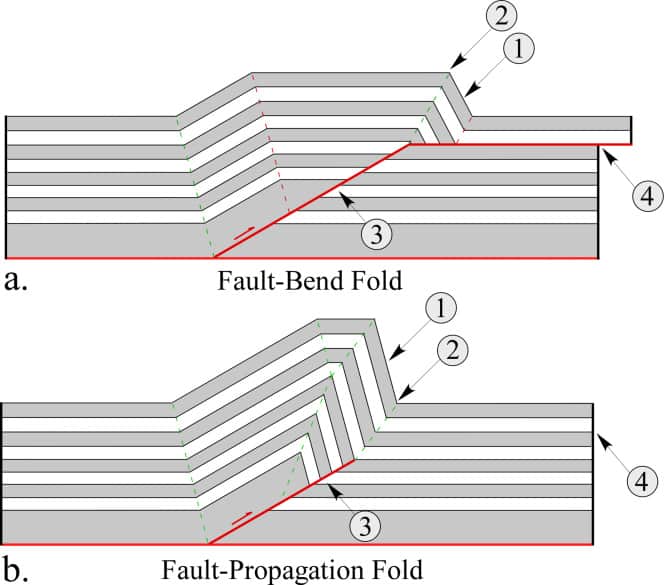
4.- References
- M. Ragan. (2009). Structural Geology: An Introduction to Geometrical Techniques, Fourth Edition. The Edinburgh Building, Cambridge CB2 8RU, UK: Cambridge University Press.
- Lutgens, F. (2012). Essentials of Geology, eleventh edition. Upper Saddle River, New Jersey 07458: Pearson Prentice Hall.
- Britannica, T. Editors of Encyclopaedia (2022, February 7). strike-slip fault. Encyclopedia Britannica. https://www.britannica.com/science/strike-slip-fault
- Britannica, T. Editors of Encyclopaedia (2020, May 11). fault. Encyclopedia Britannica. https://www.britannica.com/science/fault-geology
- Chetty, T. R. K. (2017). Proterozoic orogens of India: A critical window to Gondwana. Elsevier.
- Shankar Mitra; Fault-Propagation Folds: Geometry, Kinematic Evolution, and Hydrocarbon Traps. AAPG Bulletin 1990; 74 (6): 921–945. doi: https://doi.org/10.1306/0C9B23CB-1710-11D7-8645000102C1865D

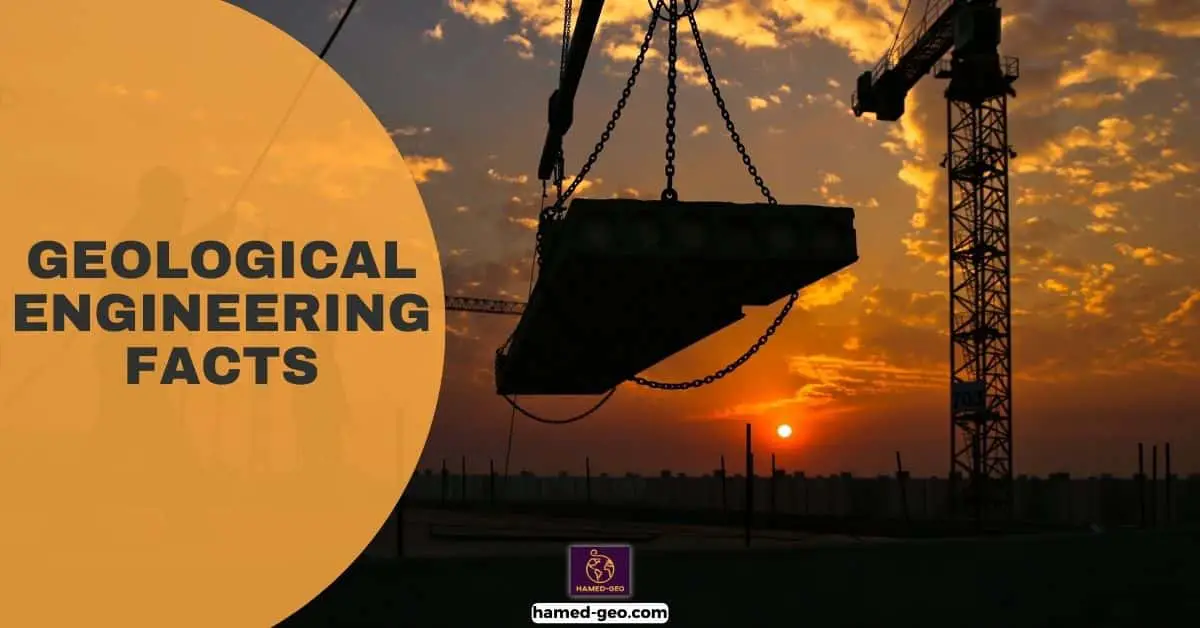

[…] places to live. These are the safest places to live because they are in areas that have no active faults or fault lines. Geologists can also help you determine if there are any possible risks that might […]
[…] The physical environment of a turbidite depositional system is characterized by a relatively deep basin with a sea-floor slope greater than about 2 degrees. The basin is typically bordered by relatively steep continental margin fault scarps. The depositional system is fed by sediment-laden flows from the margins or from within the basin. The flows are generated by slump or slide failures, debris avalanches, or, less commonly, by fault-propagated landslides. […]
[…] projects. For example, remote sensing data can be used to identify geological structures, such as faults and rock formations, and to map the distribution of soils, rocks, and vegetation. Remote sensing […]
[…] the different layers of rock and can be used to identify changes in the geologic structure, such as faults, folds, and depositional […]
[…] of these hazards in a given area. Additionally, geological surveys and mapping techniques can help identify active faults, unstable slopes, or areas prone to volcanic activity. By identifying these potential hazards, […]